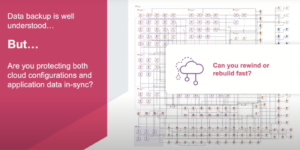Simplifying Cloud Application Resilience in a Dynamic World
Cloud-native application development promises to deliver new features and applications at business speed, with cost closely coupled to value. The focus on speed of change necessitates a greater complexity in the solution; there isn’t always time to simplify. With a mature microservices architecture, each microservice is loosely coupled, self-contained, and provides its own data and configuration protection. The reality of enterprise applications is that not everything runs in self-contained microservices; monolithic applications and microservices that share data sources are typical. These tightly coupled components and their shared data require careful protection, especially when some part of the application follows DevOps principles, but not all. How do you manage disaster recovery for this mismatched collection of enterprise production? Commvault presented the Cloud Rewind application at Cloud Field Day.
Enterprise Data and Applications in Brownfield with DevOps
Older enterprise applications typically consisted of an application server, a web server, data persistence in a SQL server, and possibly a file server. While they seemed complex at the time, those simpler architectures are now considered outdated. Modern applications are built using cloud-native microservices and are far simpler to change and update than older client-server architectures. Microservices encourage the use of multiple data persistence technologies, including object storage and non-relational databases. Building a completely new application with microservices is still a massive undertaking; often, existing applications are updated and migrated to microservices.
Migration from monolithic applications to cloud-native microservices is a gradual process, requiring them to coexist for a while (possibly permanently). The typical design pattern, known as the Strangler, involves placing a series of microservices around the existing monolith, gradually replacing the old application with a newer one. The monolith doesn’t go away; it gives rise to offshoot microservices, which are usually more tightly coupled to the monolith than we would like. Unlike microservices, monolithic applications were never designed for loose coupling. These microservices may be developed in a public cloud, with the monolith on-premises, or in virtual machines (VMs) on a public cloud. The microservices are built to change quickly, with CI/CD pipelines and numerous serverless components, but the monolith is not; waterfall development and manual deployment remain. Coordinating consistent data protection and application versioning across these vastly different platforms is challenging; a unified view would be highly beneficial. Victims of ransomware often wish for a time machine to return to the moment before the infection.
Rewind Your Cloud Application
That time machine should know the state of the many parts that make up your application, both the legacy monolith and all the modern microservices. The time machine should also be separate from the application and protected from any malware infection. For ransomware protection, Time Machine should be able to revert your application to its state at a previous time without compromising consistency across its components. For disaster recovery, or “clean room” recovery, the time machine should also be able to teleport your application to another location. Teleporting to a different cloud location, cloud account, or even a different cloud provider. Commvault demonstrated exactly this type of time machine at Cloud Field Day, specifically its Cloud Rewind technology, which enables the recovery of complex applications from catastrophic events.
Protecting Applications and Data Across Your Enterprise
Commvault is no stranger to enterprise data protection and disaster recovery. At Cloud Field Day, Commvault demonstrated various methods for providing cyber resiliency across cloud applications. You can watch all the Commvault presentations from Cloud Field Day on the Tech Field Day website.



